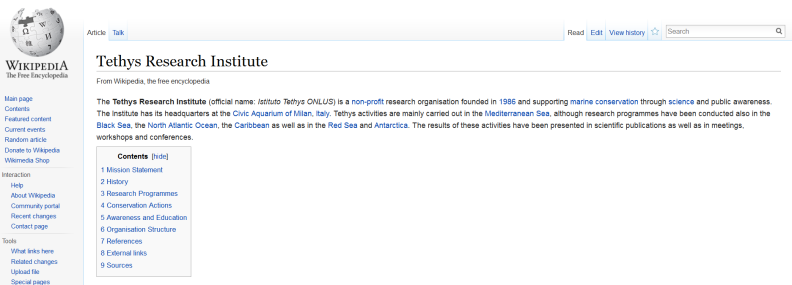The latest 29th Annual Conference of the European Cetacean Society was held in Malta just a few days ago, between the 23rd and the 25th of march, and organised by the The Biological Conservation Research Foundation, BICREF, in collaboration with the The Conservation Biology Research Group Department of Biology, Faculty of Science, The University of Malta. Amongst the several contributions, the Tethys Research Institute was in Malta with two full talks, 2 posters and 1 envited talk. Here it follows the list of the contributions:
Oral presentations
Long-term trend analysis of deep diving cetacean species occurring in the Pelagos Sanctuary (Northwestern Mediterranean Sea).
Lanfredi, C., Airoldi, S., Moulins, A., Rosso, M., Tepsich, P., Azzellino, A.
Several threats are known to affect cetacean species and their habitats in the Mediterranean sea, most of them being related to human activities. To enforce effective mitigation actions, extensive knowledge of cetacean ecology is required. In this study a 23-year sighting series (1990-2012) of sperm whale (Physeter macrocephalus), Risso’s dolphin (Grampus griseus) and Cuvier’s beaked whale (Ziphius cavirostris) was analysed to assess temporal patterns or trends in their presence in the Pelagos Sanctuary area. Sighting data were collected by Tethys Research Institute (n= 434) and CIMA research Foundation (n= 142) during shipboard surveys conducted between 1990-2012 and 2004-2012, respectively. This effort yielded a total of 576 sightings: 289 sperm whales, 164 Risso’s dolphins and 123 Cuvier’s beaked whales. For the purpose of the analysis a grid of 6.8 x 9.3 km cell units was created and used for the spatial analysis. The species’ encounter rate variability in time was analysed through a General Linear Model approach, which revealed the existence of a significant increasing trend (P<0.05) for sperm whales and Cuvier’s beaked whales presence in the area. Contrarily, no trend was found for Risso’s dolphin. This study provides evidence that the animal distribution in the Pelagos Sanctuary is affected by some drivers of change. Changes may be due to a wide range of causes (i.e. prey availabilities, climate change, noise). The correlation of the results obtained with this long term trend analysis with the available time series of environmental variables (i.e. Sea Surface Temperature and Chlorophyll-a from remote sensing) and anthropogenic pressure affecting the area (i.e. maritime traffic, fishing activities) will provide essential information to evaluate the implications of the different factors of variability and their possible interactions in order to support appropriate management and conservation strategies.
———–
The Convention on Migratory Species and the European Cetacean Society: working together to bridge policy with science in support of cetacean conservation
Giuseppe Notarbartolo di Sciara (Keynote presentation)
The Convention on Migratory Species (CMS) was adopted in 1983 to address the many threats faced by animal species which regularly cross borders between states, recognising that international cooperation is essential to the implementation of effective conservation measures for such species. Within CMS cetaceans occupy an important place, with 16 species listed as endangered in Appendix I, and 44 as requiring special agreements or cooperation for their conservation, listed in Appendix II. Of these species, many occur in European waters and will benefit from a cooperative effort between CMS and the ECS. CMS also has promoted the creation of several Agreements and MoUs among Range States to conserve cetaceans in specific regions; of these, ACCOBAMS and ASCOBANS are particularly well known within the ECS circle and have directly involved ECS members in many of their activities. Throughout CMS’ history, policy was always based on a solid scientific foundation: science has served the role of flagging issues needing urgent political attention, and of alerting to new issues, such as the danger posed by microplastics and the conservation relevance of dealing with animal culture. In turn, CMS has often served as a connective tissue creating functional links within the wider Multilateral Environmental Agreements (MEA) world, in order to achieve greater conservation effectiveness. One example among many is the 2014 Resolution on “advancing ecological networks to address the needs of migratory species”, containing an explicit encouragement to Parties to engage in the current Convention on Biological Diversity (CBD) effort on Ecologically or Biologically Significant Marine Areas (EBSAs), as well as in the application of the criteria for identifying Important Marine Mammal Areas (IMMAs) developed by the IUCN Marine Mammal Protected Areas Task Force.
———–
Conserving the Mediterranean open sea ecosystems: lessons from the Pelagos Sanctuary
Giuseppe Notarbartolo di Sciara, Simone Panigada, Arianna Azzellino, Tundi Agardy
In 2006, in response to the Johannesburg Plan of Implementation call to establish protected areas globally, the Convention on Biological Diversity (CBD) started to develop and apply criteria to describe and designate Ecologically of Biologically Significant Areas (EBSAs) in the world’s oceans, which will, inter alia, support the nations’ commitment to achieve the Aichi Biodiversity Targets by 2020. The CBD also encouraged governments and international organizations to identify and adopt measures for conservation and sustainable use in relation to EBSAs, including establishing representative networks of marine protected areas. As part of this effort, the Parties to CBD declared 15 Mediterranean EBSAs in 2014. These EBSAs could portend designation of an ecologically representative network of Mediterranean open sea marine protected areas, which would facilitate the attainment of Aichi Target 11 by the Mediterranean nations. One of the most important EBSAs identified is in the wider Northwestern Mediterranean – an area covered in part by the Pelagos Sanctuary for Mediterranean Marine Mammals. Established in 1999 by a treaty amongst France, Italy and Monaco and inscribed in 2001 in the Barcelona Convention’s List of Specially Protected Areas of Mediterranean Importance, the Pelagos Sanctuary has done much to raise awareness about the value of the area for marine mammals and biodiversity, but the current management mechanism is insufficient. Nonetheless, Pelagos is the ideal laboratory for the experimental application of a regional open seas management mechanism, to help achieve a Mediterranean MPA network by 2020. We suggest that establishing a Biosphere Reserve in the North West Mediterranean Pelagic Ecosystem EBSA, which encompasses the Pelagos Sanctuary as well as currently unprotected cetacean critical habitat to the west and the south, could offer demonstration of such a management mechanism in order to pave the way to effective region-wide conservation of the Mediterranean open seas.
———–
Posters
Diet of bottlenose dolphin (Tursiops truncatus) of the Gulf of Ambracia, Greece, through stable isotope analysis
Joan Gonzalvo, Morgana Vighi, Carme Salvador, Alex Aguilar, Ioannis Giovos, Tilen Genov, Asunción Borrell
The interactions among diet, ecology, physiology and biochemistry affect C and N stable isotope signatures in animal tissues; therefore, their analysis provides an effective means to investigate their diet and trophic relations. In this study, skin samples of 16 bottlenose dolphins (Tursiops truncatus) obtained through biopsy techniques in the Gulf of Ambracia, north-western Greece, in July 2013, were analysed for stable isotopes. Ongoing research showed the Gulf hosts a highly ‘resident’ community of about 150 dolphins. Since all 16 animals were photoidentified during the sampling process, based on our existing dolphin catalogue, it was possible to establish that 4 of them were younger than 5-years (i.e., first identified as newborns/calves in 2008/9) and 12 older. The stable isotopes of potential prey locally available in the Gulf, which included 11 species of fish, 1 crustacean and 1 cephalopod, were also analysed and the diet of the dolphins determined through a mixing model. Results indicated that dolphin diet was mostly based on horse mackerel (Trachurus trachurus), which represented about 25% of the biomass ingested, followed by species of the family Sparidae (Diplodus annularis and Lithognathus mormyrus) and of the order Clupeiformes (Engraulis encrasicolus, Sardinella aurita and Sardina pilchardus). When age-related variation was examined, younger dolphins were found to present values of δ13C and δ15N lower than the others, which indicated that young animals are likely to exploit a lower trophic level than the adults, probably due to inexperience in foraging or to some particular behavioural adaptation. It is noteworthy that bottlenose dolphins inhabiting this almost enclosed embayment are frequently engaged in surface-feeding. Gaining a better understanding of their feeding habits not only provides important information about the species, but also may be key to identify adequate management measures consistent with an ecosystem-based approach.
———–
Historical records of fin and sperm whale mortality events in the waters around Italy, 1584-2014
Nino Pierantonio and Federico De Pascalis
Fin and sperm whales are the largest cetaceans regularly occurring in the Mediterranean Sea where they classify as ‘Vulnerable’ and ‘Endangered’, respectively, according to the IUCN criteria. Considerable knowledge on their ecology has been gained during the last decades, yet limited information exists on their past mortality patterns. Here we present a review of fin and sperm whale mortality events in the seas around Italy encompassing 5 centuries. Through a review of historical and recent sources a total of 144 (46.8%) and 164 (53.2%) records were validated, for fin and sperm whales, respectively. For both species the most common event was a stranding (60.9%, 61.4%), followed by floating carcasses (15.8%) and collision events (12.8%) for fin whales and by-catch (15.7%) and deliberate killings (9.8%) for sperm whales. The spatial and temporal patterns were only investigated for strandings. Kernel Density Estimation and Hexagonal Polygon Binning showed an uneven occurrence of strandings for both species, with the majority of events occurring along gently sloping beaches, away from suitable species habitat. Strandings occurred at all times of year, but specific seasonal differences were observed. While fin whales mostly stranded during summer, the majority of sperm whale strandings occurred during spring and winter. Although strandings of both species showed a negative trend after peaking in the 1990s, an overall increase of mortality records was apparent throughout the centuries when considering all different types of events. This is most likely the result of rising research effort, as well as greater awareness of the general public. This review presents valuable baseline information for environmental history of cetaceans in a region where sea-related human activities have a long historical presence. Furthermore, they represent a useful tool to investigate the natural and man-related processes and dynamics responsible for cetacean mortality, in particular strandings.



